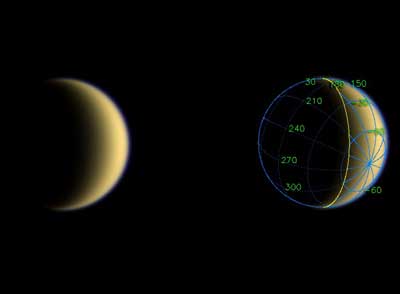Spectacular images of the moon Titan were obtained from Cassini

After Cassini's first flyby of Titan, the spacecraft photographed the moon's faded crescent shrouded in fog. This image in natural colors was taken by the spacecraft today after the closest pass by the moon. The bluish glow of the titanic nebula can be seen along the edge of the moon.
The grid of coordinates, added to the image on the right, illustrates the illuminated geographical areas of the moon and its orientation - you can see an illustration of lines of longitude, centered on the south pole of the moon near its eastern edge in the image. The yellow line marks the boundary between day and night on Titan.
Images taken through a blue filter, a green filter and a red filter were combined to create this image in natural colors. The images were taken with the help of a wide-angle camera on July 3, 2004 from a distance of about 790,000 kilometers from the Moon at a Sun-Titan-spacecraft angle (show) of 115 degrees. The scale of the image is 47 kilometers per pixel.
The Cassini Huygens mission is a joint project of NASA, the European Space Agency and the Italian Space Agency. The Jet Propulsion Laboratory (JPL), a division of the California Institute of Technology in Pasadena, manages the Cassini Huygens mission for NASA's Office of Space Sciences in Washington. The camera crew is located at the Space Science Institute in Boulder, Colorado.
